(Un)Seeing Goa’s Bom Jesus in Vishvesh Prabhakar Kandolkar’s This is Not the Basilica!
Look up most advertising content about Goa, and it will predictably have some assemblage of the words sun, sand, and sea, the coastal location on India’s west coast fitting the geographic requirements of most tropical holiday destinations. The usual clichéd seaside imagery of palm trees, surf, and sun-drenched beaches are not only replicated in the touristic visual culture that depicts Goa for the consumption of vacationers, but also perpetuates a particular look that is associated with and expected of the tropics. While Kye-Sung Chon postulates that a “destination image” is created to promote tourism (2), Krista A. Thompson reminds us of the construction of tropical imagery through recursivity (5). Thompson notes of images of holiday destinations in the Caribbean that they are “created and circulated by tourism promoters … [to form] destination images [that] can become … representative of the essential character of a place, despite the [locale’s] specificities” (5). Such specificities may include the people whose lands have become popular holidaymaking spots. Or, more precisely, the erasure or mischaracterization of the inhabitants and their role in making the culture of these locales, thereby ensuring a destination image that caters to the fantasies of visitors. Moreover, such destination images can even become so entrenched locally as to have an influence on the views people have of their own homelands and histories. And how Goans see their own heritage is a subject of much import in Vishvesh Prabhakar Kandolkar’s art.
In the case of Goa as a tourism market, it is the former Portuguese colony’s historical and architectural distinction from the rest of once-British India that is incorporated into visual representations of the tropical destination to set it apart. To this end, the structure very often co-opted is the iconic 16th-century Basilica of Bom Jesus, as Vishvesh Prabhakar Kandolkar demonstrates in his installation series, This is Not the Basilica! Displayed at Sunaparanta Goa Centre of the Arts between September 8 and November 20, 2021, Kandolkar’s research-based installations evidence how the Portuguese-era church, famous for holding the relics of St. Francis Xavier (1506-1552), has come to stand in for Goa’s historical and regional difference in South Asia while becoming a victim of its own fame. Yet, Kandolkar’s purpose is not merely to chronicle the appearance of the Basilica in everything from Goa-related tourism promos to souvenirs. Rather, Kandolkar’s works examine how visual cultures subsume history, especially in allegedly postcolonial settings. In effect, what This is Not the Basilica! seeks to achieve is an alternative form of seeing, one that challenges imposed mainstream perspectives while activating a practice of decolonial viewership that engages with local histories.
Kandolkar is an architect and architectural historian by training, as well as a professor at the Goa College of Architecture. This is Not the Basilica! marks his artistic debut as part of the group show Goa: A Time that Was, curated by Leandré D’Souza at Sunaparanta. Kandolkar’s installations showcase the long-standing Basilica as a living part of Goa rather than only an emblem of its past or a curiosity consumed by visiting tourists. Kandolkar’s intent is to destabilize how the usual representations of Goa feed into its consumption as India’s pleasure periphery (Routledge 2652), its preferred holiday destination (Ferrão 142), and real estate market for second homes (Kandolkar, “Consuming” 267). Concurrently, Kandolkar’s works draw attention to the eponymous subject of his exhibition—the Basilica of Bom Jesus—and, more specifically, the plight of the early modern monument that has served as an archetypal icon of Goa while suffering the vagaries of time, colonial politics, and climate change.
In this article, I concentrate on the decolonial approaches within Kandolkar’s art practice, especially as it emphasizes historical research and cultural knowledge. I centre Kandolkar’s efforts to recover Goan architectural heritage from the colonial past and institutional failure. Goa’s unique circumstances as an enclave that endured Portuguese colonial rule, only to then find itself under the colonial purview of the newly emerged post-British Indian nation-state, doubles the histories of coloniality the artist grapples with. Yet, in either case, Kandolkar’s focal point is the Basilica and its visual legacy as a Goan emblem of cultural and political changes between these colonial periods. Kandolkar traces the palimpsestic transformations undergone by this building over time, both in its architecture and in its visual adoption/co-option.
In This is Not the Basilica!, Kandolkar considers how Bom Jesus is sometimes a representative figure of failure and at other times a beacon of resilience. As a consequence, the artist’s installation series also raises questions about the part played by colonial, governmental, and even ecclesiastical institutions in the long life of the structure. Critical of the colonial practices that have allowed the Basilica to deteriorate, ultimately, Kandolkar’s exhibits offer a view of how the study of visual culture can decolonize our understanding of the linkages between built heritage and cultural identity. Through the use of indigenous materials in his installations, the artist deliberately brings to the fore the native knowledge that contributed to the making of the iconic monument and its history. My analysis in this regard considers how caste and gender are part of the suppressed legacy of the iconic monument, and what it means to recover these parts of the building’s heritage, especially as a means to protect it moving forward. Taking cue from Kandolkar’s work, I analyze how practices of conservation, archival research, and preservation, as well as knowledge gathering and teaching need to be revolutionized in Goa. To this end, I look to the study of art history and the participation of Goan civil society in the active recovery of their heritage as decolonial practices that reiterate the utility of projects such as This is Not the Basilica!
(Un)Seeing
The title of Kandolkar’s show is a nod to that most famous of René Magritte’s surrealist works, La trahison des images (The Treachery of Images), also known as Ceci n’est pas une pipe (This is Not a Pipe) (1929). Magritte was most interested in what art renders visible, what it allows to be seen—a concern central to Kandolkar’s own preoccupation with representing the history of Bom Jesus and reshaping the gaze directed upon it. In a 1966 letter to Michel Foucault, Magritte muses that “thought resembles … by being what it sees…; it becomes what the world offers it” (Foucault 57). Notably, John Berger’s influential book, Ways of Seeing, begins with a reference to Magritte’s observation about the insurmountable distance “between words and seeing” before stating that “[t]he way we see things is affected by what we know or what we believe” (Berger et al. 7-8). In so deciphering, Berger considers the incommensurability between seeing and expressing but also apprehends how and what may remain unseen and unexpressed. For his purposes, Kandolkar likewise uses his art to challenge how the visual history of the Basilica has, in fact, rendered much of its past unseen, as will become apparent.
Of the role of art in laying bare the unseen, Magritte holds that “painting interposes a problem: There is the thought that sees and can be visibly described … Then is the invisible sometimes visible? … [I]t is evident that a painted image—intangible by its very nature—hides nothing, while the tangibly visible object hides another visible thing” (Foucault 57). Magritte’s deliberation over how visibility itself obscures correlates quite closely to the aesthetic history of the Basilica of Bom Jesus, whose present look only came about due to a colonially motivated makeover. This political alteration of the structure’s appearance is one of the main concerns taken up by Kandolkar, especially in an effort to underscore how the anteriority of the building’s visual history has come to prevail and even be of detriment to the edifice’s future. In other words, Kandolkar’s art queries how visuality has shaped the Basilica’s legacy, the visible unrevealing of the historical manipulations it has undergone.
Taking up the question of art, representation, and the un/seen, Foucault likens Magritte’s This is Not a Pipe to a calligram, an image created from thematically linked text. But in the case of the Surrealist’s famous painting, the calligram has come undone, Foucault goes on to say, an unraveling deliberately orchestrated in the “doubly paradoxical … nam[ing of] something that evidently does not need to be named … And at the moment when he should reveal the name, Magritte does so by denying the object is what it is” (23-24). So, what is achieved by such dissembling, where the calligram “shuffles what it says over what it shows to hide them from each other” (Foucault 24)? The very design of the calligram frustrates revelation, because in order
“[f]or the text to shape itself … the gaze must refrain from any possible reading … The text must say nothing to this gazing subject who is a viewer, not a reader. As soon as [the viewer] begins to read, … shape dissipates … [T]he calligram never speaks and represents at the same moment. The very thing that is both seen and read is hushed in the vision, hidden in the reading.” (Foucault 24-25)
Ultimately, the words and images in their non-collusion divulge that “[n]owhere is there a pipe,” as Magritte’s purpose is to indicate that “the letters are but the image of letters … [and] the figure is only the didactic continuation of a discourse” (Foucault 29). In Foucault’s analysis, what Magritte makes apparent “[f]rom painting to image, from image to text … [is the imposition of] a system of references, [that] tries to stabilize a unique space” (30). Meaning lies beyond its imposition and what is made intentionally visible. So, too, with This is Not the Basilica!, Kandolkar attempts to disentangle the image of the Basilica from its present day, seeking out the legendary building’s longer history to posit a different way of seeing (or salvaging) it.
Seeing through Walls
Upon entering the darkened gallery where Kandolkar’s installations are placed, visitors to Sunaparanta are immediately greeted by the curious sight of suspended, backlit latticed palm leaves that cast dramatic shadows on the wall. This scrim of entwined foliage forms part of the title piece in the exhibition This is Not the Basilica! But a closer look would reveal that the interwoven fronds obscure a large image that can only be properly viewed by navigating around the leafy screen. Forced to peer through the network of leaves, visitors catch sight of a digitally manipulated photograph of one of the Basilica’s red laterite walls, lashed by rain and with some of its windows surrounded by lime plaster. The stark whitewash around the casements in the image is an embellishment not visible in the actual building, but what remains true to life in the photograph are perceptible signs of the laterite wall crumbling. In fact, the pediment over one of the windows in the picture has completely vanished. The patchwork lime render and the enmeshed palm leaves a mystery, the clue to this installation’s meaning lies in the long history of Bom Jesus which only looks as it presently does due to a politically induced renovation.
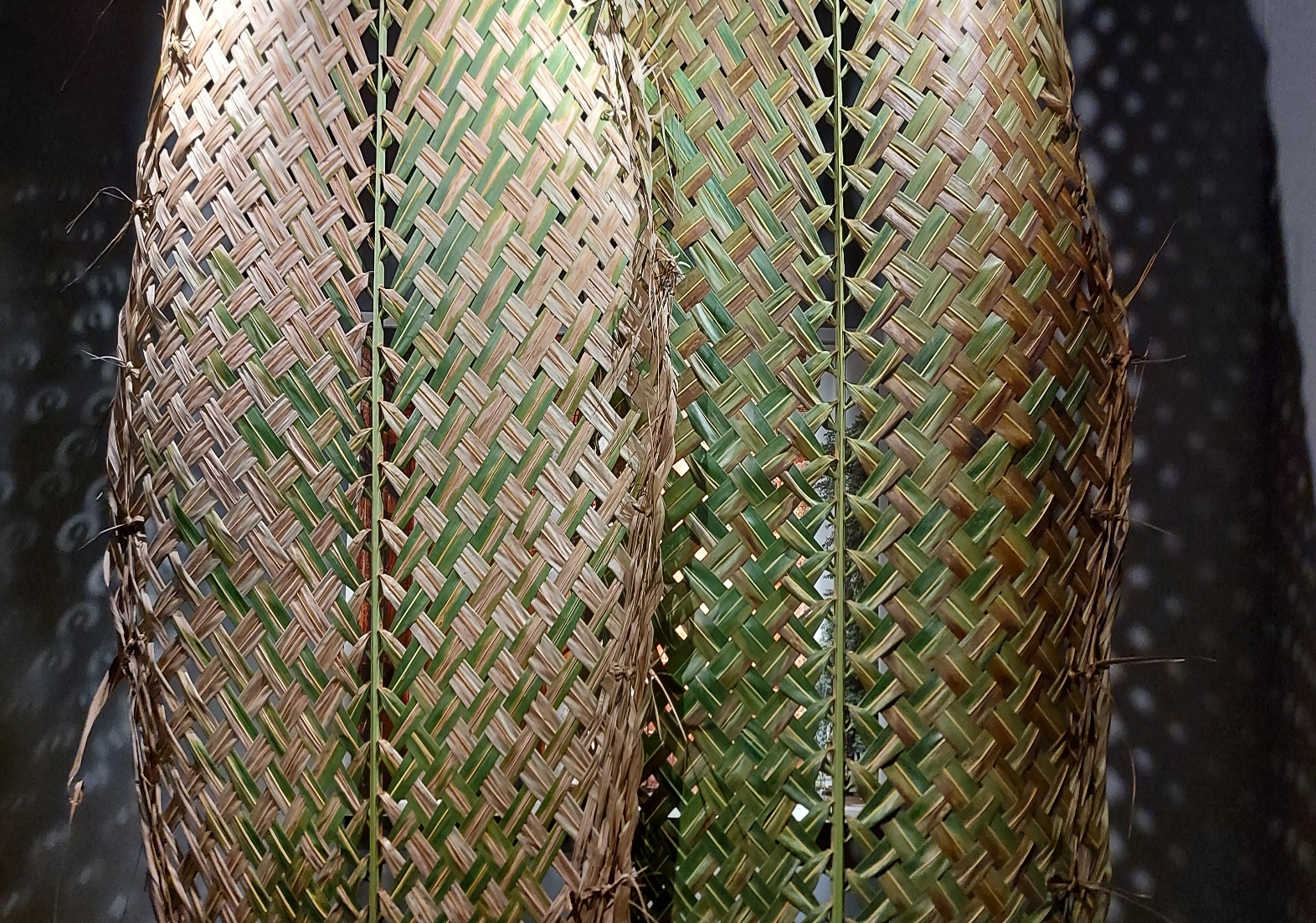
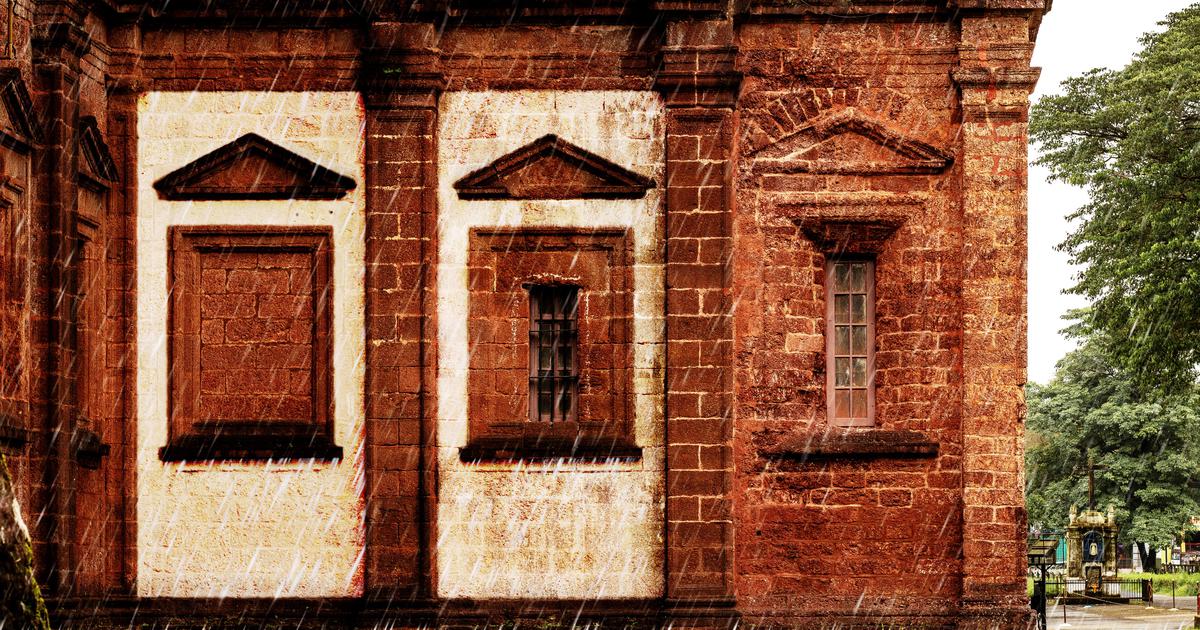
As the curator’s note highlights, Bom Jesus “is one of the few surviving monuments from the fabled period of Old Goa and an emblem of Indo-Portuguese aesthetics” (D’Souza). Capital of the Estado da Índia from the early-1500s, the colonial Portuguese seat of government in Old Goa, for a time, oversaw an empire that encompassed regions as far apart as Africa and eastern Asia, as well as various locales in South Asia. With construction beginning in 1594, the history of the Basilica of Bom Jesus ran almost parallel to that of the duration of Portuguese India, now even having outlived it with the 1961 annexation of Goa by India. Yet, although the church may have been built during the period of Portuguese rule, its aesthetic is definitively Goan while demonstrating what Kandolkar identifies as “the flowering of Baroque style architecture in Goa” (“Symbol of Goan Identity”).
The legend of the Basilica was sealed when it became the final resting place of the Basque Jesuit missionary Saint Francis Xavier in the 17th century, some fifty years after his death. As Pamila Gupta ascertains, despite Xavier’s demise in 1552 in Sancian, an island off the coast of China, Goa was chosen as the site where his remains would be relayed, a choice made collusively by church and state (Relic State 51). The Portuguese colonial state as well as the Iberian-founded Jesuits, whose purview now extended beyond Spain and Portugal to their colonies, sought to benefit from an attachment to Xavier’s storied legacy of miracles performed in his overseas missionary work. The relocation of Xavier’s body may have had to do with the saint’s “[strong] biographical attachments to [Goa],” but also because, as the capital of Portuguese Asia, Goa had become “a developed centre of colonial and missionary activity” by the time of the saint’s death (Gupta, Relic State 51).
The housing of Xavier’s illustrious relics at the Basilica apart, the edifice’s architectural innovations are additionally prominent. In Whitewash, Red Stone: A History of Church Architecture in Goa, Paulo Varela Gomes recounts the church’s discernibly European influences. Yet, these were remade in Goa, by Goan artisans, according to local taste, bringing together such disparate features as “Flemish ornament, Serlian mouldings, round windows and French Serlian window frames” in the building’s constitution (69). To foreground the Basilica’s place in Goa’s architectural history, these very words quoted from Varela Gomes’ book appear in the gallery that displayed Kandolkar’s exhibits at Sunaparanta. What should be gleaned from this, as well, is that the adaptation of European church architecture by Goans was also confirmation of the localization of Catholicism in the region since early modernity. Elements of localized baroque, as seen in the Basilica, found their way into the design of other churches of the day, Varela Gomes maintains (69). Likely, this was also true of non-church architecture in the period, domesticated European Renaissance design influences even featuring in Goa’s Brahmanical temple forms in the 17th century (Kanekar 254).
Indeed, as I state at the outset, a major draw for Indian sojourners in Goa is its Iberian influence as translated locally in the region’s built culture, a heritage that has given rise to much sought after and so-called “Portuguese homes” (Menezes, “Portuguese Architecture”). Referring to such nomenclature as a “lobotomised real estate shorthand,” Vivek Menezes underscores how the housing market uses Goa’s Portuguese colonial cachet to advertise the territory and its architecture to Indian buyers (“Portuguese Architecture”). That Goa, a Portuguese colony from 1510, was annexed by India in 1961, thirteen years after the latter’s own independence from the British, heavily inflects the colonially consumeristic relationship traceable here, one that inscribes Goa as a colony of a postcolony. If the 1961 takeover replaced Goa’s European colonizers with Indian ones, while circumventing the self-emancipation efforts of Goans themselves (Lawrence 9-10), Goa’s Portuguese past makes it the other to the Indian nation-state whose history and postcolonality are largely defined by its formerly British colonial heritage.
These issues are the impetus for Kandolkar’s second installation, (T)here is the Basilica. The multimedia exhibit includes, among other elements, video loops from Indian national television that feature the appearance of the Basilica in tableau on Goa’s floats in some of the yearly Republic Day parades (2019 being the most recent iteration of the inclusion of the structure), as well as print advertisements that use images of the church to shill holidays and real estate in Goa. The title of the installation explores the distance between the cultural and historical “there” and “here” of the postcolonial nation and its colony, the centre and periphery. This is poignantly dramatized in Kandolkar’s use of a video segment that shows the Basilica as an emblematic representation of Goa, alongside floats epitomizing other states, in the annual Republic Day parade in New Delhi, India’s capital. If the Basilica is a symbol of Goa’s Portuguese past, situated as it is in the former capital of the now bygone Estado da Índia, then its simulacral reemergence in a national event celebrating the creation of the post-British Indian Republic collapses Goan history into a mainstream national narrative.
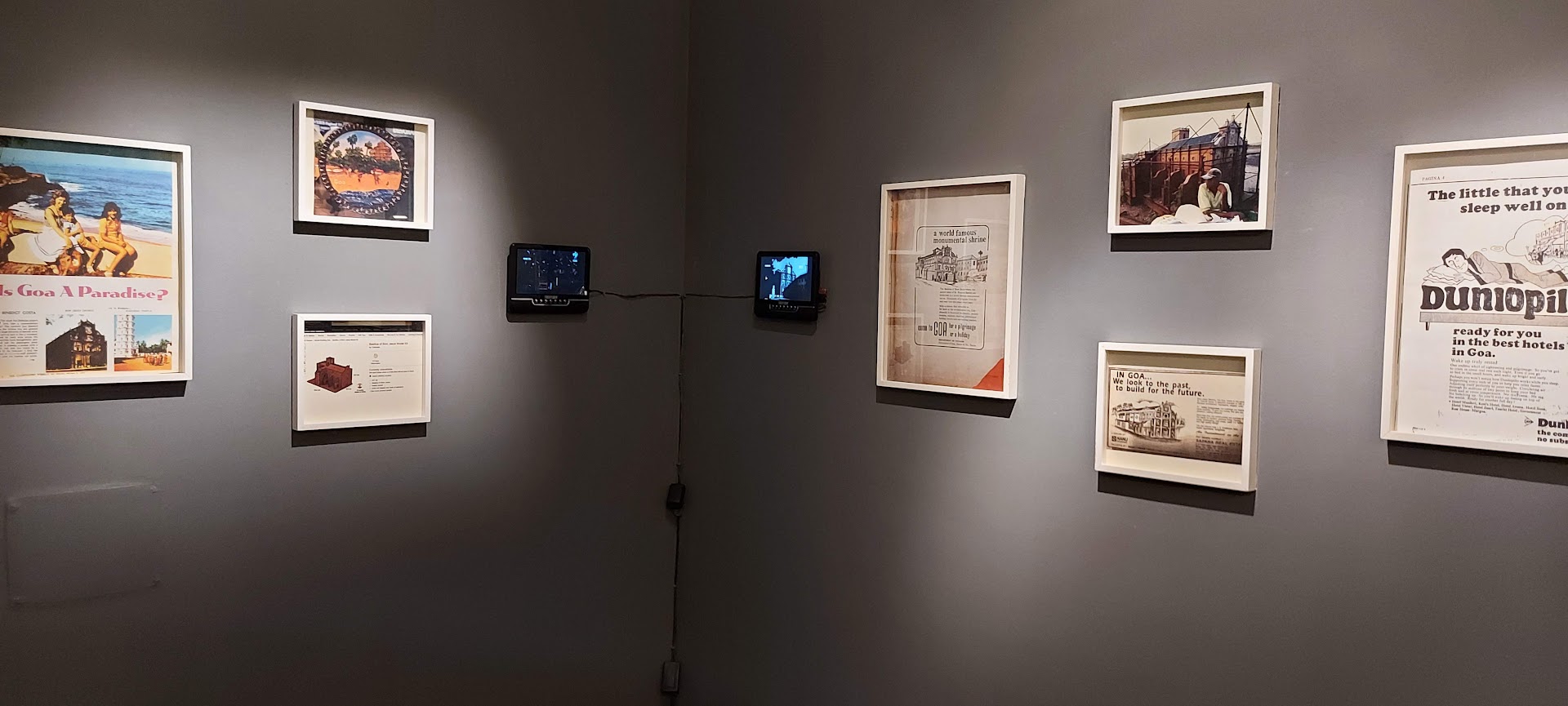
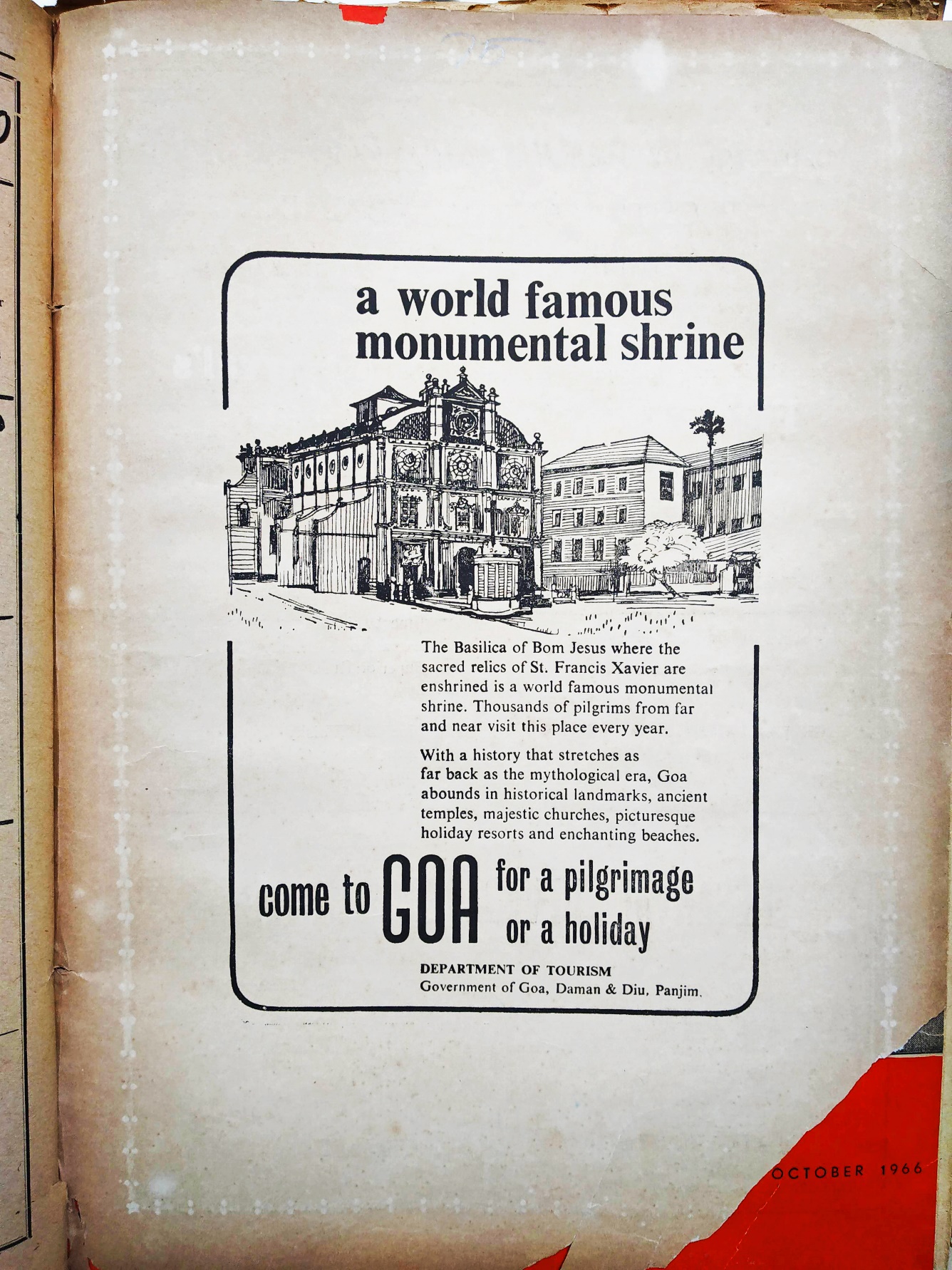
This occurs even as the presence of the representational Basilica seems to gesture at Goa’s cultural and religious specificities, a perfunctory, orchestrated, and performative nod to the multiculturalism of contemporary India as is to be seen in the array of territorially illustrative floats. Simultaneously, (T)here is the Basilica’s use of print media that traces how the Basilica has been co-opted into consumeristic representations of Goa for the consumption of Indian tourists and real estate buyers bears witness to the insidiousness of capitalism as colonialism. Writing on this subject, Kandolkar takes cognizance of how Goa’s Portuguese colonial aesthetic heritage, as is made manifest in its architecture, is advertised to “Indian urban elites” who are enticed to “[buy] ‘a piece of Goa’ … [and] what this land signifies: an exotic ‘laidback’ Goan lifestyle” (“Consuming” 267). These orientalizing notions of the salubriousness of life in Goa deriving not only from its coastal location but also from the territory’s association with supposed easy-going Iberianness, lead Kandolkar to propound that “Indian elites are manufacturing the idea of Goa as an internal space of difference in order to consume it” (“Consuming” 268).
The Indian misnaming of Goan architecture of colonial derivation as “Portuguese homes” is indicative of much misinformation about Goa and its people’s own hand in their heritage-making; even as they seek out purportedly Portuguese architecture, what Indian buyers are actually hoping to acquire are structures of historically Goan creative origin. As further evidence of the built form in Portuguese Goa bearing testament to local inventiveness, consider how the façade of the Basilica of Bom Jesus melds European and South Asian design. This look was achieved through the use of basalt quarried from Bassein (mirroring the hard stone used in the façades of European churches of that era), while other external parts of the church were built in the now ever-emblematic red laterite that is native to Goa. With one massive difference—the laterite brick with which the Basilica was constructed was rendered invisible. Coated as it was with lime plaster, the Basilica once looked like so many other whitewashed churches that dot Goa’s landscape of red hills and green palms. It was not until the 1950s that the Basilica gained the look it wears now, purposefully denuded of its white lime render by political design.
(In)Visible
Joaquim Rodrigues dos Santos chronicles how Portuguese architect Baltazar da Silva Castro was tasked in the mid-20th century with restoring Goan monuments, including the Basilica, by then-Portuguese Prime Minister António de Oliveira Salazar (244-245). Restoring is really not the appropriate term, for Castro had been instructed to age such early modern Portuguese Goan relics as the Basilica by reverting them to their alleged “original shapes” (Rodrigues dos Santos 245). The intention was for these historical structures to appear even older than they really were. In the wake of the decolonization of adjoining British India in 1947, Salazar sought to demonstrate Portugal’s longstanding influence on Goa and its culture (245). As part of his propaganda to justify the continued presence of Portugal in its overseas territories in South Asia, Salazar believed that architecturally fabricating the antiquity of the Portuguese presence in its erstwhile capital of Old Goa was a viable tactic to achieve this goal. The avenue through which this was to be realized was by giving famous sites, tied to the early modern Portuguese empire, a reverse facelift.
In the case of the Basilica of Bom Jesus, this meant that it was entirely stripped of its protective white plaster barrier (Rodrigues dos Santos 247). No doubt this achieved the required outcome of making the already historic building appear even more ancient by making visible the porous and primeval-looking laterite that for centuries had been sheathed by lime render. This resulted in the (seemingly) quintessential look the monument bears now. If the aesthetic of ageing historic structures like Goa’s Bom Jesus establishes anything, it is that the Portuguese colonial enterprise was clutching at straws to retain the vestiges of its influence in the Indian Ocean arena. While these politically supported architectural reforms did little to sustain Portuguese rule in Goa, they incontrovertibly left their mark on the Basilica and the visual culture premised upon the metamorphosed edifice. For example, (T)here is the Basilica, includes a webpage for a three-dimensional model kit of the unplastered church available for sale online. This image, along with other advertisements and tourism-related paraphernalia in the installation, shows how the more recent vision of the monument as an imposing red-brown laterite building has been immortalized in the present time. To recount Magritte’s pronouncement, “the tangibly visible object hides another visible thing” (Foucault 57). In proffering the many mediated iterations of the Basilica’s current look, sans white walls, Kandolkar’s installations remind viewers that what they see of the church conceals its past, hiding it in plain sight.
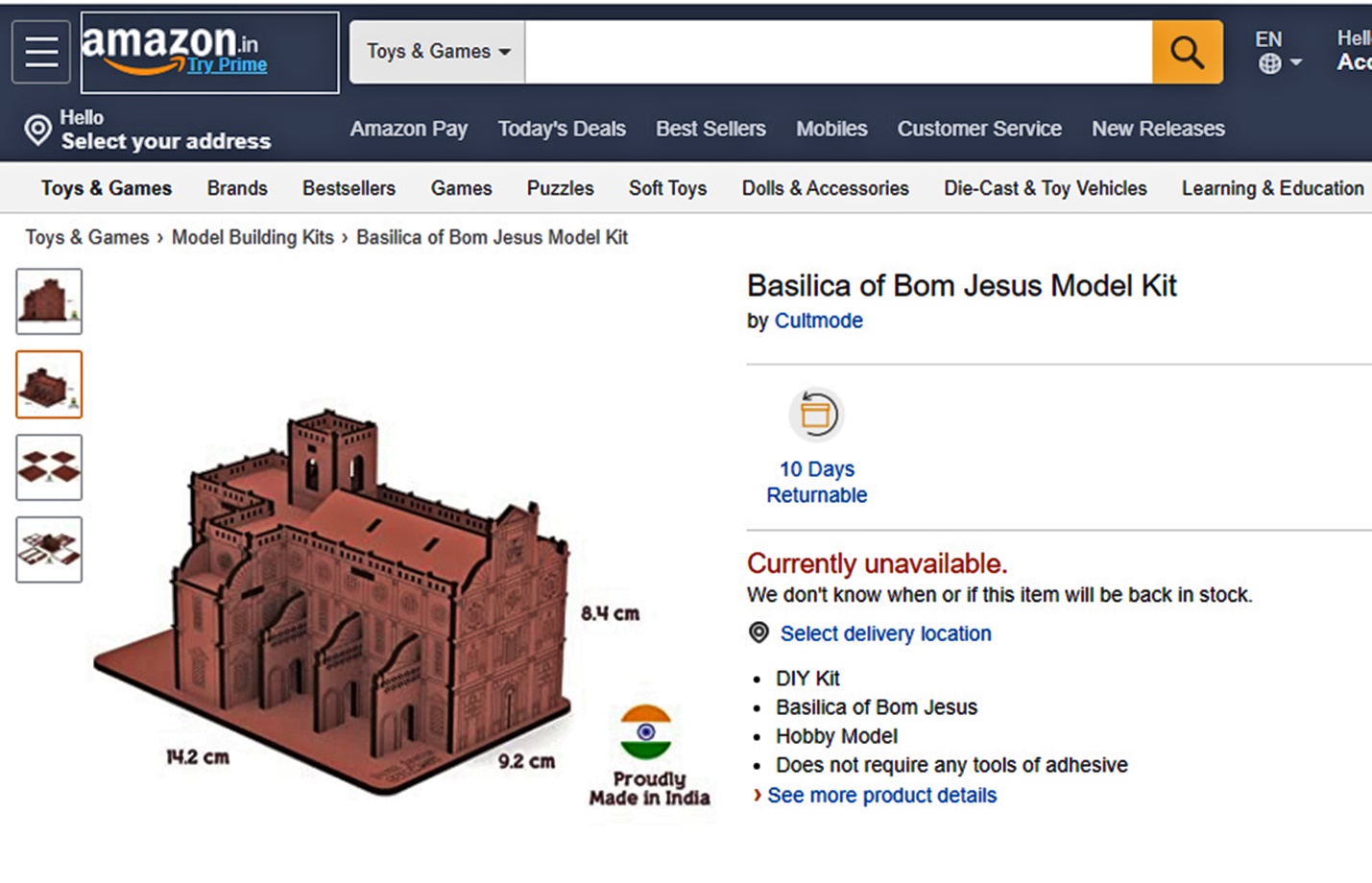
Heavy Rain, Low Visibility
An entire generation of Goans will have only known the Basilica in its present form, devoid of its once highly contrasting white plaster surfaces. And why should this be a problem? The lime cast which was removed during Castro’s renovation was not meant to merely serve as a decorative element, its presence on the church’s walls functioning as prophylaxis against rain damage. A protectant of indigenous origin, lime plaster is a material that continues to be used in protecting other Goan structures presently. Laterite rock is naturally water-permeable, its constitution deteriorating with extended exposure to rainfall, a consistent and recurrent phenomenon in monsoonal Goa. As Kandolkar finds in his tellingly titled article “Rain in the Basilica: Protecting Goa’s Bom Jesus from the Ravages of Climate Change,” this is a problem that will only be exacerbated by climate change which has manifested in Goa “[o]ver the last century … [in] an increase of over 68% in rainfall … [which is] devastating to architectural heritage” (97).
Debates have raged about maintaining the Basilica’s current look (Fernandes), especially so as not to upset the sentiments of Goans who have become habituated to seeing, and worshiping at, the unplastered church, which is one of the most popular in the region because of the presence of Xavier’s relics (Kandolkar, “Restoring”). But things came to a head in April 2020 when it became apparent that drastic measures needed to be taken to conserve the building—the rain had found its way into the church (Kandolkar, “Rain” 96). The press picked up the story when the Basilica’s rector, Fr. Patricio Fernandes, wrote a letter to the Archeological Survey of India, accusing them of being negligent of the care of the monument, which falls under their purview (“ASI”; “Urgent Efforts”). While the furor resulted in expedited repairs of the church’s leaking roof (Monteiro), the question about whether the Basilica will once again be plastered—its best defense against the torrential rains Goa experiences (Velho)—still remains unresolved. It is this uncertainty that Kandolkar intervenes in, using his installations to offer an alternate vision of the Basilica’s lifetime.
Through the Looking Grass
Much like the Goanness of the Basilica in its adaptation of European design influences, grass-like woven palm frond awnings are of particularly Goan provenance in material and design as Paul Melo e Castro points out (14). Once commonplace in Goa, the craft of enmeshing coconut palm leaves to create a protective barrier around built structures, especially during the monsoons, is a vanishing skill (Kandolkar, “Rain” 106). Instead, mass produced plastic tarpaulins have come to stand in for mollam, as handwoven palm leaf sheaths are known in Konkani. Changes like these, where mollam have given way to the less eco-friendly plastic coverings, are proof of the passage of time and evolutions in technology. Parallelly, the walls of Bom Jesus have endured transformations inflected by politics and history. By incorporating the re-enlivened tradition of defending architecture against the monsoons with the use of mollam, Kandolkar’s exhibit invites visitors to rethink how one views architectural history and aesthetics and, indeed, the art of seeing itself. Barely visible through the mesh of leaves from Goa’s ubiquitous coconut trees (seen so stereotypically in tourism advertisements for Goa), the image of the Basilica of Bom Jesus that Kandolkar offers is less obscured than it is renewed. It is a glimpse through the past to see what the future could hold for the endangered building.
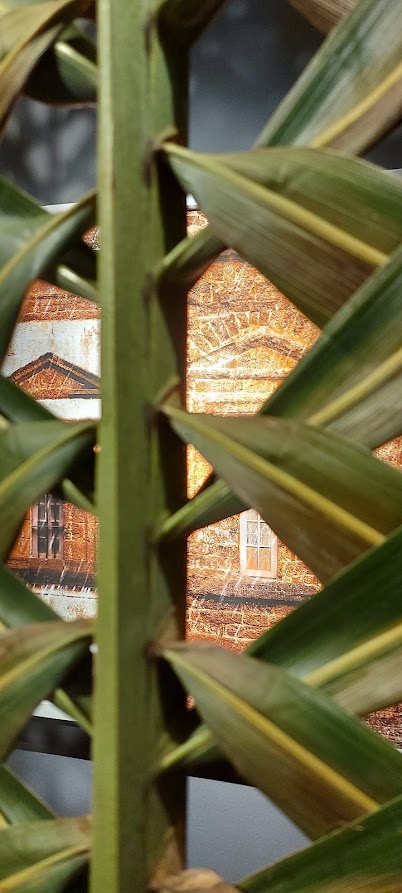
The use of the mollam as an obscuring curtain also embroils viewers interactively, causing them to seek out the hidden image within the installation. This element of the installation is reminiscent of the work of Gustav Metzger, whose Historic Photographs series comprises images that are also exhibited in concealed form. In a 2007 interview, Metzger explains that the inspiration for the series came from an Italian newspaper photograph he saw in 1990, which depicted “two Israeli policemen with guns, guarding a group of [Palestinian] Arabs lying on the ground: it was the ‘Massacre on the Mount’ [at Al-Aqsa Mosque], and it caused a furore worldwide” (in Godfrey). To thwart the ephemerality of news media, Metzger chose to re-represent the photograph in enlarged form, but hid it behind a sheet. The artist titled the installation To Walk Into—Massacre on the Mount, Jerusalem, 8 October 1990 (1996). In addition to memorializing the massacre of Palestinians, Metzger’s title also provides directions on how to interact with his work. As Metzger describes, “[Viewers] had to walk … under the [cloth] and scrape or feel the [photograph], which was part of my point … [T]here are arguments along the lines that Jews dominate Arabs as a kind of revenge to being dominated by Nazis. So this is the topic for discussion” (Godfrey). The importance of this subject was one that was close to the late Jewish artist’s heart, having escaped the holocaust by fleeing from Germany to England as a child on the Kindertransport in 1939 (Searle). Creating interactivity, Metzger’s use of concealment “[forces] viewers to uncover and confront the image nose-to-nose … [It] counteracts a passive, spectatorial consumption of violence” (Tse). The confrontation also re-engages the viewer with history; a similar ethos informs Kandolkar’s art, inviting viewers to grapple with and see history differently.
Behind the Backdrop
In creating an interface between the photograph and viewers, This is Not the Basilica! shifts the positions of what should be the backdrop versus the focus of attention. The image of the Basilica becomes secondary to the backdrop—the grid of leaves—which, here, frames how the picture is to be viewed but is, in fact, the first thing a spectator sees. The resemblance to Magritte’s work is in the way the Surrealist uses a phrase to frame how the pictured pipe is (not) to be seen; likewise, Kandolkar advises his viewers that what they believe to be how the Basilica looks now, is not how it should be seen. Thus, the would-be backdrop takes centre stage in This is Not the Basilica! as it commands and controls the gaze of the viewer. Speaking to the role of backdrops in studio photography, Arjun Appadurai suggests that they “can be interpreted as sites of epistemological uncertainty about exactly what photographs seek to represent,” for “backdrops constitute a peculiar counter-context to the [… photograph],” even managing to function allegorically in their own vein (5).
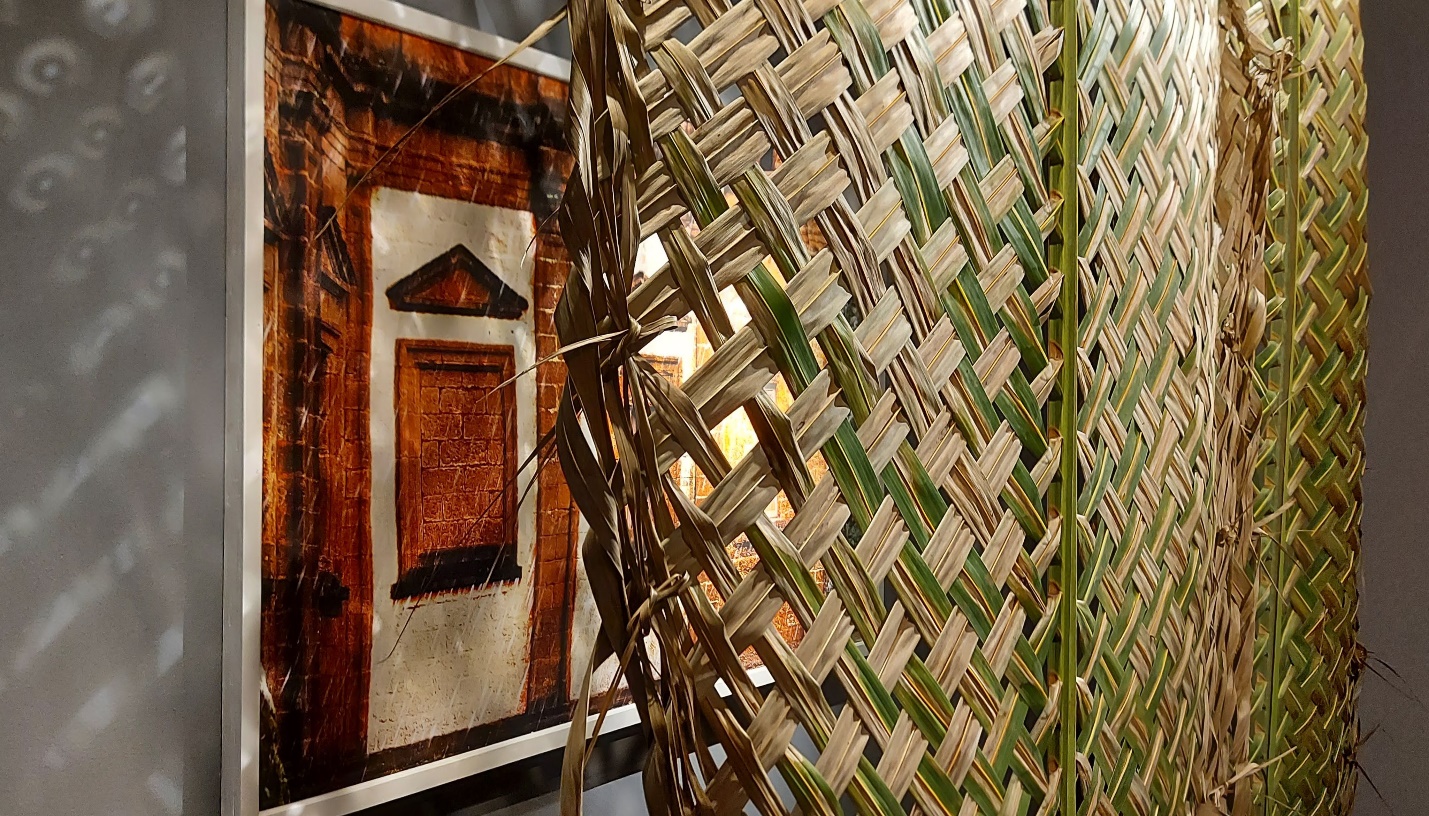
The use of mollam in This is Not the Basilica! pointedly brings to the fore traditional methods of architectural protection employed by Goans commonly in the past. The allegory offered is that similar indigenous protective practices (in its case, the use of lime render) had once helped the Basilica withstand the onslaught of time and weather. Appadurai contends that backdrops create “the major site for localizing” an image at the same time as they “provide occasions for rehearsing new positions” postcolonially; this is because backdrops “remain a place where the meanings of modernity can be contested and where experiments with the means of modernity can be conducted” (6-7). The mollam in Kandolkar’s installation instills a backdrop of local materiality and historicity, one through which the artist gives his viewers the opportunity to reckon with past and present as they consider the Basilica’s future. Recall that the Salazarist intervention that deplastered the Basilica in the 1950s created its modern-day look by, ironically, aging the building—a technological advancement in aid of de-modernizing its look. Reversing this trend, contesting its meaning-making, what might be achieved by experimenting with past traditions, reinvigorating them for a new take on modernity? Just as mollam could stand in for plastic tarpaulin as an environmentally sound option for protecting buildings against rainfall, so too could the reuse of once-traditional plaster give the Basilica a new lease on life.
In identifying native practices in the legacy of the Basilica, Kandolkar is equally interested in the labour that informed such heritage, especially with regard to caste and gender. For This is Not the Basilica!, Kandolkar communicated to me in an interview that he commissioned Pingal Prakash Mashelkar, a caretaker at Sunaparanta, to fashion the mollam used in his installation; the artist also acknowledges Mashelkar’s contribution in the exhibition pamphlet (D’Souza). This employment of local knowledge in the artwork chronicles skills that, though in disuse, have not disappeared. Mashelkar’s ability to call up a practice that she is not otherwise engaged in may speak to the gendered nuances of how traditional skills are passed on generationally, their sustenance occurring even when their uses lie dormant. What this might also signal is the forms of subaltern conservational knowledge that have contributed to keeping the Basilica standing for nearly five centuries. The past work of plastering the building would have been done by labourers employed for this purpose who would have been experienced in such techniques. If on the one hand the church’s design evidences how “[Goan] artisans … domesticate[d] European architectural and ornamental vocabulary, [making] it their own” (Varela Gomes 70), the work of the Basilica’s upkeep would have fallen to those in the caste hierarchy pressed into such service but whose ability to perform these functions drew from vital stores of native knowledge. Thus, Kandolkar’s pairing of the contemporary photograph of the rain-lashed red-walled Basilica with the mollam of yesteryear not only offers a portrait that interrogates the monument’s condition and how it may be viewed, but also the legacies of political involvement, artistry, and subaltern labour that have come to attend it over the centuries of its existence.
The Vanishing of Local History
In a 2021 public talk held online, Kandolkar explained that Bom Jesus “continues to remain unplastered because people have been fed a particular misrepresentation of the monument’s appearance in the contemporary moment” (“Looking”). In fact, what might help Goans come around to seeing the Basilica differently is a re-engagement with a visual culture that sidesteps contemporary representations of the edifice and provides a longer look at the church in its earlier form. With this in mind, Kandolkar’s third and final installation Weather the Basilica? employs a timeline that starkly shows the difference between the short period during which the church has been unplastered and the significantly longer duration of its having been protected by a coat of lime mortar. To visually represent the contrast, the installation makes use of untreated laterite bricks and rubble, sourced from Old Goa, standing in a vitrine balanced atop a tall, whitewashed pedestal. What becomes clear from the timeline matched with the dimensions of the exhibit is that it is the most recent period (represented by the raw laterite) that has borne witness to the most damage sustained by the Basilica. This coincides with the removal of the lime layer, a rise in monsoonal rainfall, and planetwide climate change.
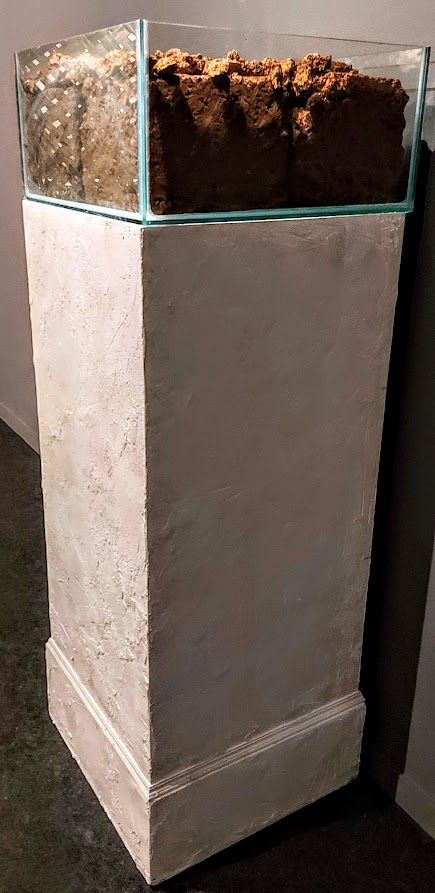
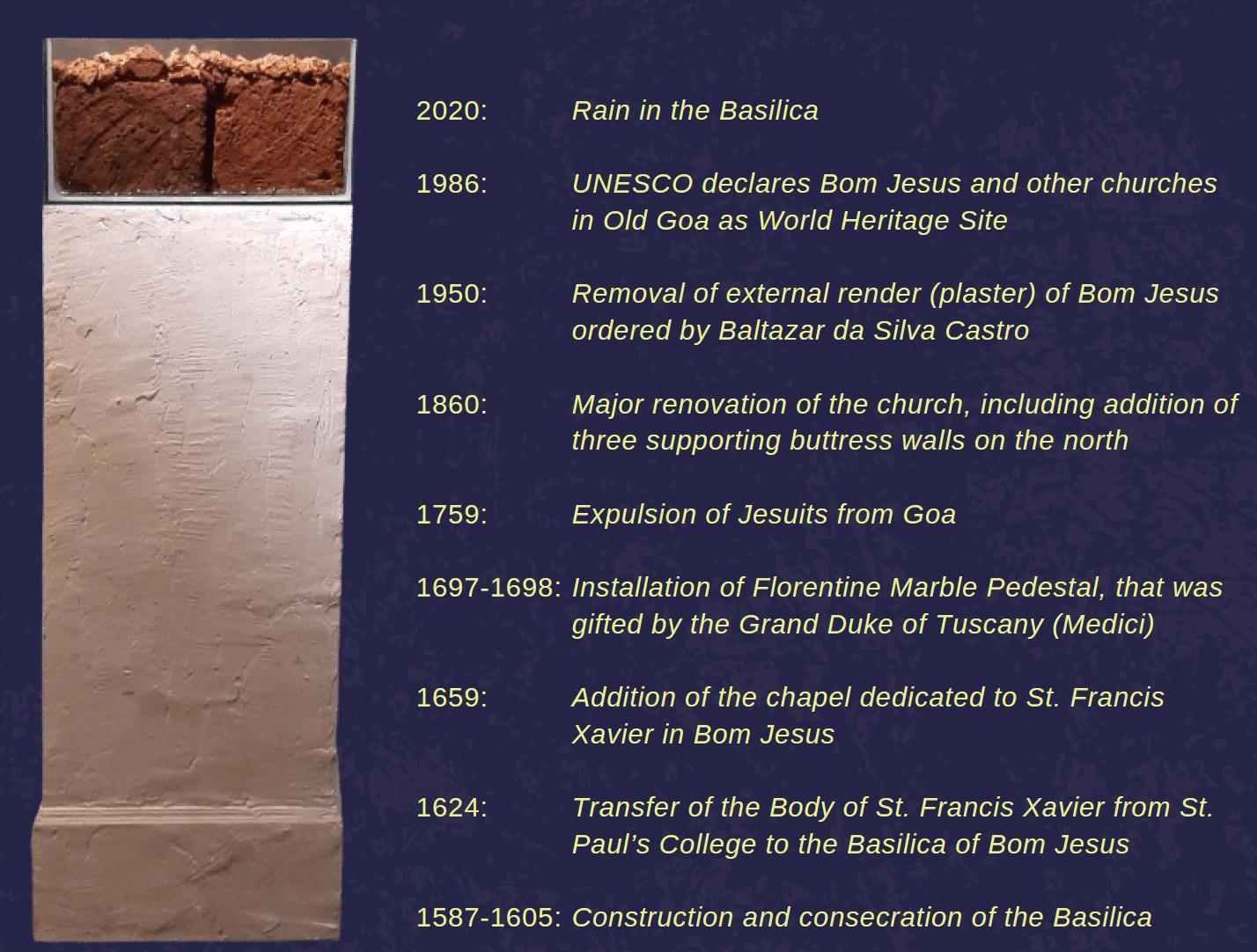
In the face of overwhelming knowledge that the Basilica’s unplastered state continues to be of detriment to the early modern building, why would public opinion tend toward leaving it as is rather than have it revert back to its pre-1950s’ condition? This question is apt, especially given that it has only been the most recent decades within this nearly half-millennium old church’s lifespan that has seen it devoid of plastered walls. As Kandolkar advises, this has much to do with the lack of information available to the Goan public about their own architectural history and its attendant visual culture. This lack of knowledge about local history is undergirded by the putative postcoloniality of Goa as is evidenced by the dictates of India’s education system.
The nationalist ilk of Indian postcolonial education available in Goa precludes the incorporation of regional studies broadly and local art and architectural studies more specifically. At its independence from Britain, India desired to make radical ideological changes in creating new curricula at the federal level, but did not have the financial capacity to “[provide] high-quality education to [all Indian] children” (Sherman 505). States and regions were left to create and fund their own curricula because of the federal government’s financial inabilities (505). Regardless, the development of educational programs across the country was unified in its exclusion of “foreign [educational] content … developed under colonial rule,” following critiques by Indian nationalists (505-506). Sangeeta Kamat characterizes India’s national curriculum guidelines, even at the start of the 21st century, as being predicated on the idea that “Otherness is … a generalized ‘West’, with specific reference to the history of British colonial rule” (279). If, as has already been established, Indians think of Goan architecture as being Portuguese, studies of local built forms or representative visual cultures associated with them, such as photographic histories of the Basilica, would find no room in local curricula in Goa. That church-built forms are associated with Catholicism adds a further complication in considerations of the suitable Indianness of architectural heritage, their presence in Goa relegated to Portuguese coloniality rather than the living heritage of Goans (Kandolkar, “Reclaiming”). Coequally, civic engagement with the arts in Goa has also been undermined for politically motivated reasons, state support generally being earmarked to aid public cultures of art that delimit Goa’s connections, and influences from, beyond the subcontinent (Menezes, “the Goan”).
The Lost Photograph
The reason many latter-day Goans are unaware that the Basilica was not only once plastered, but that this was how it appeared for the greater part of its existence, is simply because they have never seen pre-1950s’ images of the monument in this state; they would not have been exposed to such visual knowledge in their schooling nor in public venues, given the institutional biases outlined above. This does not mean that visual representations of the once-plastered Basilica do not exist. Arguably, the most famous of these is an 1890 photograph of the Basilica taken by Souza and Paul. This duo is closely tied to the history of photography in Goa, being “[t]he first [studio] photographers to establish themselves [there] … in 1884,” Goan art historian Savia Viegas records (5). Viegas deciphers that inasmuch as “[t]he photographs of Souza & Paul appropriated the imperial gaze, [they focused] more on locations than people, and undoubtedly were created for the consumption of viewers both, from Portugal and from the colonies” (7). What cannot be refuted, then, is that the photographs Souza and Paul took, especially of “cathedrals and church towers” (7), circulated in Portugal and Portuguese Goa, this being the precise intent of the photographers who were in the business of creating images for profit. Between the late 19th century and the Salazarist retrograding of the Basilica mid-20th century, perhaps other images of the plastered monument had also circulated alongside lived experience and living memory of the popular church.
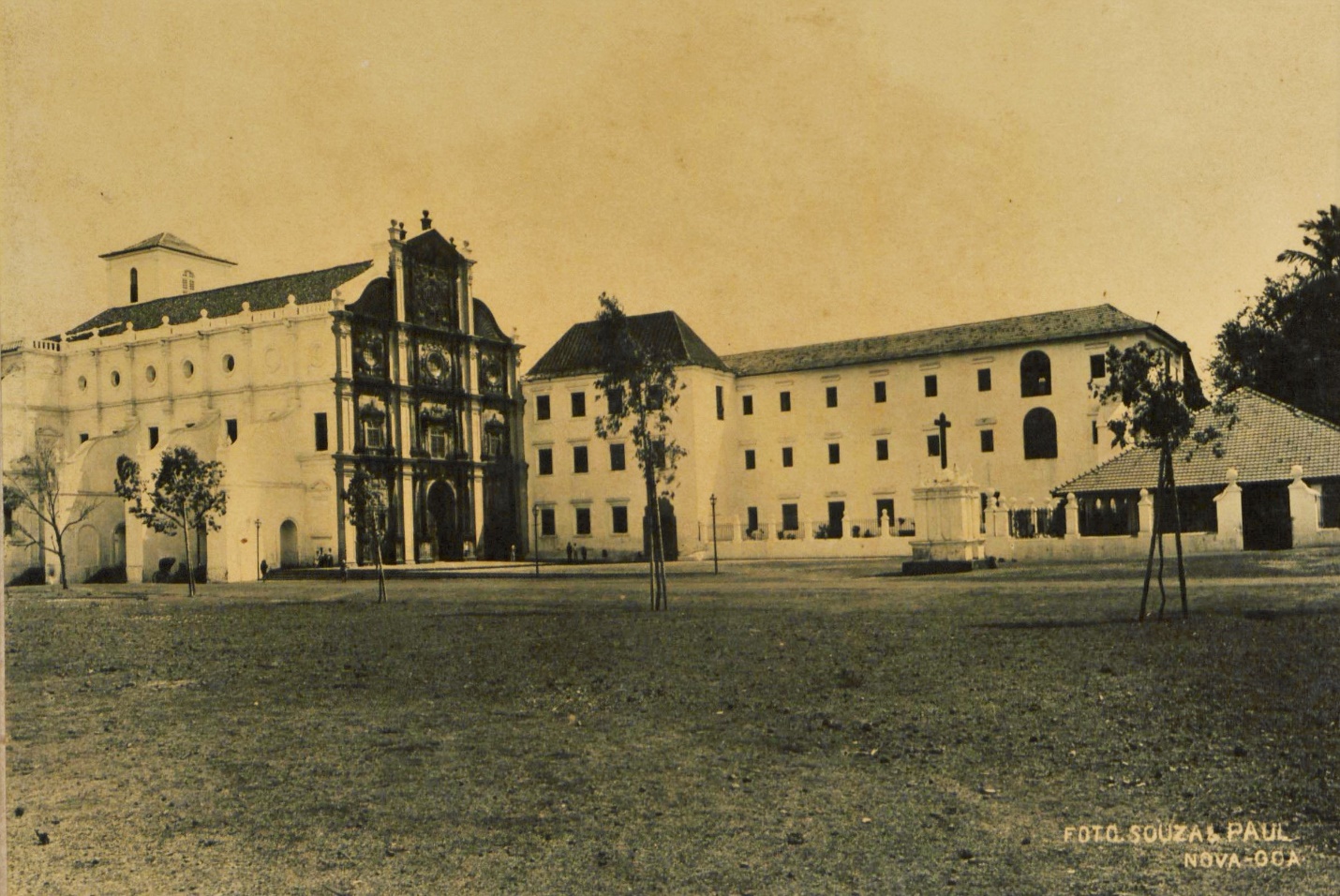
Since, images of the whitewashed Basilica taken by Souza and Paul (and others) have fallen out of Goa’s visual culture and memory. In this vacuum, the more apparent image of the church is the one that reiterates its contemporary look, a red-brown Bom Jesus sans plaster. This is an image that has become synonymous with Goa today and part of its destination image, especially in the multitudinous replications of this likeness across media, as Kandolkar’s installation series proves. In capturing the earlier history of the Basilica in his installations, Kandolkar asks his viewers to broaden their visual lexicon and to re-immerse themselves in Goan architectural history. Such an intervention, through the use of visuality, its history and cultures, coincides with Pamila Gupta’s insistence on the vital use of “visual archives to think about … representations of Goan-ness” (“Visuality” 258).
The pertinence of such a call applies quite specifically to the Basilica and its history, given that it was and is a vibrant part of Goan culture. For instance, the Basilica is the site of an annual celebration of Xavier’s feast day, as well as a decadal exposition of his sacred remains. These events draw large crowds of Goans, an occurrence that Kandolkar declares,
“signals the participants’ connection to the Catholic site as one that, while obviously borne out of religious affiliation, may additionally speak to other possibilities, including an attempt to resist the homogenisation of their culture with that of a Hindu India. That non-upper-caste Catholics and other Goan minority subjects—themselves seeming relics of a colonial past—see in the relics of the saint the possibility of celebration and the need for constant commemoration speaks to the symbolic importance of Xavier, and the architecture that surrounds him.” (“Reclaiming”)
The cultural and religious significance of these Basilica-based events then also recommends that they be viewed as part of Goa’s historical record. If state and other archives contain the visual evidence of these gatherings with the once-plastered church in view, surely such imagery could be resurfaced. However, is it political will, as Kandolkar reckons, that may inhibit the recirculation of such historical images, the Basilica and its environs, “Old Goa[, being] more marketable as [ruins]” (“Reclaiming”)?
What may be equally revealing of such a contention is that an investment in perpetuating the “[fossilization of] the community whose history, culture, and memory are an inextricable component of these monuments” (Kandolkar, “Reclaiming”) may also explain the lethargy of the official response to intervening in the preservation of the Basilica (“ASI”). In lieu of this, the uninterrupted ruination of the Basilica by keeping it unmortared, as well as the lack of upkeep of the rest of Old Goa, “provide touristic locations to service the neo-liberal economy” (Kandolkar, “Reclaiming”). And yet, these efforts to musealize Old Goa are interrupted because it is not only special events that bring the Goan faithful to Old Goa; besides it being a shrine for Xavier’s relics, Bom Jesus operates as a local parish church with regular services. Between these quotidian uses of the church and special events, Kandolkar proposes that Goans “demonstrate that the monuments are an extension of themselves. By participating in the very monumentalisation of these edifices, Goans signify their refusal to be rendered insignificant—an act of resistance against their erasure in their own homeland, Goa” (“Reclaiming”).
For the Basilica of Bom Jesus to continue to serve the Goan public as it has over the centuries, its replastering is an immediate necessity. As Vishvesh Prabhakar Kandolkar’s This is Not the Basilica! urges, the structure needs to be seen differently, not only as it now appears but as it once was. A renewed interaction with the church’s visual history would benefit this reenvisioning, efforts that Kandolkar’s installations initiate but that need to be maintained by resurfacing and making commonplace past evidence of the Basilica’s former appearance. “Suppose a photograph is a lyric for the future,” Anjali Arondekar contemplates (“Only You” 86), hinting at “the promise of archival presence as future knowledge” (“Reliable Ghosts” 99). When allowed to, a photo can make known so much, not only of its own moment but also in providing direction for the future. But as I have been contending, making Goans intimate with the past through the discovery of their (visual) heritage requires institutional reform, an initiative that must range across systems of education, archival practice, and civic engagement with the arts. Such institutional collaborations hold the promise of an interdisciplinary framework for architectural preservation, one that can empower Goans to see their history anew and the future of their heritage more knowledgably. This can potentially reverse the erasure of Goan heritage-making by empowering Goans as stakeholders in the revelation and preservation of their own history. Stephen Sheehi conveys how “[t]he photograph is a social product and therefore an assemblage of meaning, production, technology, economy, and social forces” (401-402). In this vein, to know the visual history of the Basilica is also to know its place in the lives of Goan people, as well as their contribution to the church’s creation and sustenance. To see it as such is to see the Basilica as more than just a monument of and to the past, for it continues to be a palimpsest of unfolding Goan identity.
Acknowledgments
I would like to thank Vishvesh Prabhakar Kandolkar for his generosity and assistance as this article was being researched. My gratitude to William & Mary’s program in Asian and Pacific Islander American Studies for its support of this work through the provision of an Asian Centennial Faculty Fellowship. Finally, thanks are due to the San Mateo Public Library’s Shut Up & Write! program where this article was initiated.
Works Cited
Appadurai, Arjun. “The Colonial Backdrop.” Afterimage, vol. 24, no. 5, 1997, pp. 4-7.
Arondekar, Anjali. “In the Absence of Reliable Ghosts: Sexuality, Historiography, South Asia.” differences: A Journal of Feminist Cultural Studies, vol. 25, no. 3, 2014, 98-122.
Arondekar, Anjali. “Only You.” Foam, no. 60, 2021, p. 86.
“ASI has Neglected Conservation of the Basilica at Old Goa: Rector.” O Heraldo, 24 April 2020, https://www.heraldgoa.in/Goa/ASI-has-neglected-conservation-of-the-Basilica-at-Old-Goa-Rector/159763. Accessed 10 September 2021.
Berger, John, Sven Blomberg, Chris Fox, Michael Dibb, and Richard Hollis. Ways of Seeing. British Broadcasting Corporation and Penguin Books, 1973.
Chon, Kye-Sung. “The Role of Destination Image in Tourism: A Review and Discussion.” The Tourist Review, vol. 45, no. 2, 1990, pp. 2-9.
D’Souza, Leandré. “Goa: A Time that Was.” Goa: A Time that Was – An Exhibition of Photography. Sunaparanta Goa Centre of the Arts, 2021.
Fernandes, Paul. “Goans Accustomed to Seeing the Laterite Walls of Basilica, but it Needs Restoration: Experts.” The Times of India, 27 March 2021, https://timesofindia.indiatimes.com/city/goa/goans-accustomed-to-seeing-laterite-walls-of-basilica-but-it-needs-restoration-experts/articleshow/81715420.cms. Accessed 10 September 2021.
Ferrão, R. Benedito. “Running Naked and Unmasked in Goa.” eTropic, vol. 20, no. 1, 2021, pp. 134-156.
Foucault, Michel. This is Not a Pipe, translated by James Harkness, U of California Press, 1983.
Godfrey, Mark. “Protest and Survive: An Interview with Gustav Metzger, One of the Key Figures of Postwar British Art.” Frieze, no. 108, 6 June 2007, https://www.frieze.com/article/protest-and-survive. Accessed 20 September 2021.
Gupta, Pamila. The Relic State: St Francis Xavier and the Politics of Ritual in Portuguese India. Manchester UP, 2014.
Gupta, Pamila. “Visuality and Diasporic Dynamism: Goans in Mozambique and Zanzibar.” African Studies, vol. 75, no. 2, 2016, pp. 257-277.
Kamat, Sangeeta. “Postcolonial Aporias, or What Does Fundamentalism Have to Do with Globalization? The Contradictory Consequences of Education Reform in India.” Comparative Education, vol. 40, no. 2, 2004, pp. 267-287.
Kandolkar, Vishvesh Prabhakar. “The Basilica of Bom Jesus: A Symbol of Goan Identity.” Sahapedia, 18 May 2018, https://www.sahapedia.org/the-basilica-of-bom-jesus-symbol-of-goan-identity. Accessed 10 September 2021.
Kandolkar, Vishvesh Prabhakar. “Reclaiming Goan Identity through the Feast of Saint Francis Xavier.” Economic and Political Weekly of India, vol. 48, no. 7, 2019, https://www.epw.in/engage/article/reclaiming-goan-identity-through-feast-saint. Accessed 15 September 2021.
Kandolkar, Vishvesh Prabhakar. “Consuming Goa Portuguesa: Vacationing in a Postcolonial Colony.” Journal of Human Values, vol. 26, no. 3, 2020, pp. 266-276.
Kandolkar, Vishvesh Prabhakar. “Restoring Basilica of Bom Jesus, and the Role of Archeological Survey of India.” Economic and Political Weekly of India, vol. 55, no. 36, 2020, https://www.epw.in/engage/article/restoring-basilica-bom-jesus-and-archaeological-survey-india.
Accessed 10 September 2021.
Kandolkar, Vishvesh Prabhakar. “Looking beyond the Surface: The Visual History of the Basilica of Bom Jesus.” Basilica of Bom Jesus in Goa: Past, Present and (which) Future? ARTIS – Instituto de História da Arte (Faculdade de Letras da Universidade de Lisboa) and Goa College of Architecture (University of Goa), 25 March 2021.
Kandolkar, Vishvesh Prabhakar. “Rain in the Basilica: Protecting Goa’s Bom Jesus from the Ravages of Climate Change.” ETropic: Electronic Journal of Studies in the Tropics, vol. 20, no. 2, 2021, pp. 95-113.
Kandolkar, Vishvesh Prabhakar. Interview. Conducted by R. Benedito Ferrão, 28 August 2021.
Kanekar, Amita. “The Politics of Renovation: The Disappearing Architecture of Goa’s Brahmanical Temples.” Preserving Transcultural Heritage: Your Way or My Way? Questions on Authenticity, Identity and Patrimonial Proceedings in the Safeguarding of Architectural Heritage Created in the Meetings of Cultures, edited by Joaquim Rodrigues dos Santos, Caleidoscópio, 2018, pp. 253-263.
Lawrence, Leo. Nehru Seizes Goa. Pageant Press, 1963.
Melo e Castro, Paul. “Introduction – The Cartography of Goan Literature in Portuguese: One Language in a Multilingual Social Landscape.” Colonial and Post-Colonial Goan Literature in Portuguese: Woven Palms, edited by Paul Melo e Castro, U of Wales Press, 2019, pp. 1-16.
Menezes, Vivek. “How the Goan Lost his Art: The Old Secretariat Chapter.” The Times of India, 25 August 2013, https://timesofindia.indiatimes.com/city/goa/How-the-Goan-lost-his-art-The-old-secretariat-chapter/articleshow/22050192.cms. Accessed 15 September 2021.
Menezes, Vivek. “‘Portuguese Architecture’ in Goa has Little to do with the Portuguese and Everything to do with Goa.” Scroll, 13 November 2017, https://scroll.in/magazine/856585/portuguese-architecture-in-goa-has-little-to-do-with-the-portuguese-and-everything-to-do-with-goa. Accessed 10 September 2021.
Monteiro, Lisa. “Basilica Roof Repairs to be Completed in Two Weeks: ASI Goa.” The Times of India, 24 April 2020, https://timesofindia.indiatimes.com/city/goa/basilica-roof-repairs-to-be-completed-in-2-weeks-asi/articleshow/75335261.cms. Accessed 10 September 2021.
Rodrigues dos Santos, Joaquim. “On the Trail of Baltazar Castro, a Portuguese Restorer in India.” EAHN 2015 Belgrade: Entangled Histories, Multiple Geographies, edited by Vladan Djokić, Ana Nikezić, and Ana Raković, University of Belgrade - Faculty of Architecture, 2017, pp. 277-286.
Routledge, Paul. “Consuming Goa: Tourist Site as Dispensable Space.” Economic and Political Weekly, vol. 35, no. 30, 2000, pp. 2647-2656.
Searle, Adrian. “Gustav Metzger: An Artist Who Tore Down the Old to Build the New.” The Guardian, 2 March 2017, https://www.theguardian.com/artanddesign/2017/mar/02/gustav-metzger-artist-appreciation. Accessed 20 September 2021.
Sheehi, Stephen. “The Nahḍa After-Image: Or All Photography Expresses Social Relations.” Third Text, vol. 26, no. 4, 2012, pp. 401-414.
Sherman, Taylor C. “Education in Early Postcolonial India: Expansion, Experimentation and Planned Self-Help.” History of Education, vol. 47, no. 4, 2018, pp. 504-520.
Thompson, Kara A. An Eye for the Tropics: Tourism, Photography, and Framing the Caribbean Picturesque. Duke UP, 2006.
Tse, Gabrielle. “Para Site’s Threadbare ‘Curtain.’” ArtAsiaPacific, 25 July 2021, http://www.artasiapacific.com/Magazine/WebExclusives/ParaSitesThreadbareCurtain. Accessed 20 September 2021.
“Urgent Efforts are Needed to Ensure Basilica is Protected for Future Generations: Fr Patricio.” The Navhind Times, 23 April 2020, https://www.navhindtimes.in/2020/04/23/goanews/urgent-efforts-needed-to-ensure-basilica-is-protected-for-future-generations-fr-patricio/. Accessed 10 September 2021.
Varela Gomes, Paulo. Whitewash, Red Stone: A History of Church Architecture in Goa. Yoda Press, 2011.
Velho, Fernando. “The Long Shadow of Goa’s Dying Basilica.” O Heraldo, 13 December 2020, https://www.heraldgoa.in/Review/The-long-shadow-of-Goas-dying-Basilica-/168601. Accessed 10 September 2021.
Viegas, Savia. Moments, Memory & Memorabilia: An Intimate Journey through Photographs. Fundação Oriente, 2015.
Image Notes
Figure 1: Woven Palm Detail from This is Not the Basilica! (2021). Photo by the author.
Figure 2: Uncovered Photo Detail from This is Not the Basilica! (2021). Photo courtesy of Vishvesh Prabhakar Kandolkar.
Figure 3: Wide View of (T)here is the Basilica (2021). Photo by the author.
Figure 4: Detail from (T)here is the Basilica (2021). Photo courtesy of Vishvesh Prabhakar Kandolkar.
Figure 5: Detail from (T)here is the Basilica (2021). Photo courtesy of Vishvesh Prabhakar Kandolkar.
Figure 6: This is Not the Basilica! (2021), view through the Mollam. Photo by the author.
Figure 7: Side View of This is Not the Basilica! (2021). Photo by the author.
Figure 8: Weather the Basilica? (2021). Photo by the author.
Figure 9: Accompanying Timeline to Weather the Basilica? (2021). From the curator’s note.
Figure 10: The Basilica of Bom Jesus (Old Goa), photographed in 1890 by Souza and Paul Photo courtesy of Goa State Central Library.